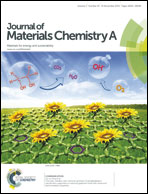Design of tetraphenyl silsesquioxane based covalent-organic frameworks as hydrogen storage materials†
Abstract
Four types of tetraphenyl silsesquioxane based covalent-organic frameworks (sil-COFs) were designed with the ctn and bor net topologies using molecular mechanics. The computed results revealed that these sil-COFs possess excellent structural properties, such as high porosity (89–95%) and large H2 accessible surface area (5476–6331 m2 g−1), which is advantageous to hydrogen storage. The H2 adsorption isotherms of these sil-COFs were simulated using the grand canonical Monte Carlo (GCMC) method at 77 K and 298 K. The simulated results indicated that at 77 K, sil-COF-4 has the highest gravimetric hydrogen storage capacity of 36.82 wt%, while sil-COF-1 has the highest volumetric hydrogen storage capacity of 63.53 g L−1. At 298 K, sil-COF-4 has the highest gravimetric hydrogen uptake of 5.50 wt%, which already exceeds the U.S. Department of Energy's goal (4.5 wt%) for 2017 and is also very close to the criterion of 6 wt% for practical applications of hydrogen at room temperature. In addition, two possible schemes are proposed to synthesize the sil-COFs.


 Please wait while we load your content...
Please wait while we load your content...